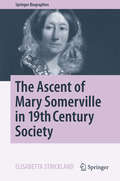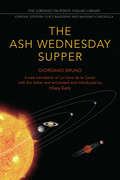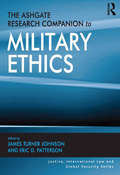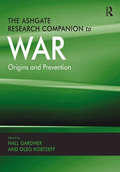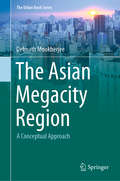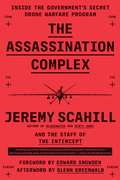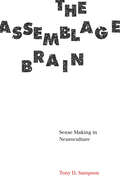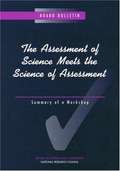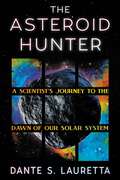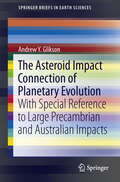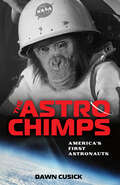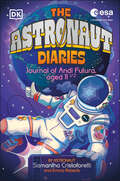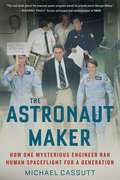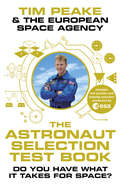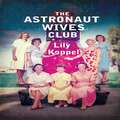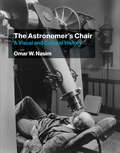- Table View
- List View
The Ascent of Man
by Jacob BronowskiLauded by critics and devoured by countless readers as a companion to the acclaimed PBS series, this work traces the development of science as an expression of the special gifts that characterize man and make him preeminent among animals. Bronowski's exciting, splendidly illustrated investigation offers a new perspective not just on science, but on civilization itself.
The Ascent of Mary Somerville in 19th Century Society
by Elisabetta StricklandThis biography traces the life and work of Mary Fairfax Somerville, whose extraordinary mathematical talent only came to light through fortuitous circumstances. Barely taught to read and write as a child, all the science she learned and mastered was self taught. In this delightful narrative the author takes up the challenge of discovering how Somerville came to be one of the most outstanding British women scientists and, furthermore, a popular writer. Particular attention is paid to the gender aspects of Somerville's success in what was, to put it mildly, a predominantly male domain.
The Ash Wednesday Supper: A New Translation (Lorenzo Da Ponte Italian Library #4)
by Hilary Gatti Massimo Ciavolella/Luigi Ballerini Giordano BrunoGiordano Bruno’s The Ash Wednesday Supper is the first of six philosophical dialogues in Italian that he wrote and published in London between 1584 and 1585. It presents a revolutionary cosmology founded on the new Copernican astronomy that Bruno extends to infinite dimensions, filling it with an endless number of planetary systems. As well as opening up the traditional closed universe and reducing earth to a tiny speck in an overwhelmingly immense cosmos, Bruno offers a lively description of his clash of opinions with the conservative academics and theologians he argued with in Oxford and London. This volume, containing what has recently been claimed as the final version of Bruno’s Ash Wednesday Supper, presents a new translation based on a newly edited text, with critical comment that takes account of the most current discussion of the textual, historical, cosmological and philosophical issues raised in this dialogue. It considers Bruno’s work as a seminal text of the late European renaissance.
The Ashgate Research Companion to Military Ethics (Justice, International Law and Global Security)
by Eric D. Patterson James Turner JohnsonThis Companion provides scholars and graduates, serving and retired military professionals, members of the diplomatic and policy communities concerned with security affairs and legal professionals who deal with military law and with international law on armed conflicts, with a comprehensive and authoritative state-of-the-art review of current research in the area of military ethics. Topics in this volume reflect both perennial and pressing contemporary issues in the ethics of the use of military force and are written by established professionals and respected commentators. Subjects are organized by three major perspectives on the use of military force: the decision whether to use military force in a given context, the matter of right conduct in the use of such force, and ethical responsibilities beyond the end of an armed conflict. Treatment of issues in each of these sections takes account of both present-day moral challenges and new approaches to these and the historical tradition of just war. Military ethics, as it has developed, has been a particularly Western concern and this volume reflects that reality. However, in a globalized world, awareness of similarities and differences between Western approaches and those of other major cultures is essential. For this reason the volume concludes with chapters on ethics and war in the Islamic, Chinese, and Indian traditions, with the aim of integrating reflection on these approaches into the broad consideration of military ethics provided by this volume.
The Ashgate Research Companion to War: Origins and Prevention
by Hall Gardner Oleg KobtzeffMany different social scientists have been challenged by the origins of wars, their immediate causes and the mechanisms leading to the breakdown of peaceful relations. Many have speculated whether conflicts were avoidable and whether alternative policies might have prevented conflict. The Ashgate Research Companion to War provides contributions from a number of theorists and historians with a focus on long term, systemic conflicts. The problèmatique is introduced by the Editors highlighting the need for interdisciplinary approaches to the study of war as a global phenomenon. The following 29 essays provide a comprehensive study guide in four sections: Part I explicates differing theories as to the origins of war under the general concept of 'polemology'. Part II analyzes significant conflicts from the Peloponnesian wars to World War II. Part III examines the ramifications of Cold War and post-Cold War conflict. Part IV looks at long cycles of systemic conflict, and speculates, in part, whether another global war is theoretically possible, and if so, whether it can be averted. This comprehensive volume brings us a much needed analysis of wars throughout the ages, their origins, their consequences, and their relationship to the present. A valuable understanding that is ideal for social scientists from a variety of backgrounds.
The Asian Megacity Region: A Conceptual Approach (The Urban Book Series)
by Debnath MookherjeeThis book argues that close and disciplined scrutiny of the Asian megacity regions is of critical importance to understanding Asian urbanization. However, any approach to studying these regions must adopt a multi-dimensional and trans-urban perspective; otherwise, we Without such an approach, we cannot truly make meaningful decisions about growth management and sustainable development for such regions. Amidst the sweeping demographic and structural shifts produced by global urbanization, Asian urbanization has a fascinating and prominent role. Asian urbanization is heterogeneous, and more accurately constitutes “phenomena” than a “phenomenon.” However, despite this diversity, there are certain common features that we can identify. One of them is the Asian “megacity region”— the administrative and/or delineated territory of mixed urban-rural landscape surrounding a giant metropolis.The purpose of this book is to: Understand the main features of 21st century urbanization Note the limitations of current approaches (e.g. disparate scales, city-centric views, inadequate data sets)Articulate a pragmatically framed three-pronged approach (scale-based, trans-urban, multi-dimensional)Demonstrate the application of such an approach with a case study of one of the most important megacity regions in South Asia, the Delhi National Capital Region, underscoring the methodological requirements of such an approach Discuss the next steps for the field as a whole: questions to be raised and directions to be explored for further study. This timely, conceptual and empirical book will appeal to students of urbanization, architects involved in urban policy and planning, and researchers alike.
The Aspergilli: Genomics, Medical Aspects, Biotechnology, and Research Methods (Mycology)
by Gustavo H. Goldman Stephen A. OsmaniWith high-quality genome sequences for the important and ubiquitous Aspergilli now available, increased opportunities arise for the further understanding of its gene function, interaction, expression, and evolution. The Aspergilli: Genomics, Medical Aspects, Biotechnology, and Research Methods provides a comprehensive analysis of the researc
The Assassination Complex: Inside the Government's Secret Drone Warfare Program
by Jeremy Scahill The Staff of The InterceptMajor revelations about the US government's drone program--bestselling author Jeremy Scahill and his colleagues at the investigative website The Intercept expose stunning new details about America's secret assassination policy.When the US government discusses drone strikes publicly, it offers assurances that such operations are a more precise alternative to troops on the ground and are authorized only when an "imminent" threat is present and there is "near certainty" that the intended target will be killed. The implicit message on drone strikes from the Obama administration has been trust, but don't verify. The online magazine The Intercept exploded this secrecy when it obtained a cache of secret slides that provide a window into the inner workings of the US military's kill/capture operations in Afghanistan, Yemen, and Somalia. Whether through the use of drones, night raids, or new platforms yet to be employed, these documents show assassination to be central to US counterterrorism policy. The classified documents reveal that Washington's fourteen-year targeted killing campaign suffers from an overreliance on flawed signals intelligence, an apparently incalculable civilian toll, and an inability to extract potentially valuable intelligence from terror suspects. This campaign, carried out by two presidents through four presidential terms, has been deliberately obscured from the public and insulated from democratic debate. The Assassination Complex allows us to understand at last the circumstances under which the US government grants itself the right to sentence individuals to death without the established checks and balances of arrest, trial, and appeal. The book will include original contributions from Glenn Greenwald and Edward Snowden.
The Assemblage Brain: Sense Making in Neuroculture
by Tony D. SampsonOnce upon a time, neuroscience was born. A dazzling array of neurotechnologies emerged that, according to popular belief, have finally begun to unlock the secrets of the brain. But as the brain sciences now extend into all corners of cultural, social, political, and economic life, a yet newer world has taken shape: &“neuroculture,&” which goes further than ever before to tackle the profound ethical implications we face in consequence.The Assemblage Brain unveils a major new concept of sense making, one that challenges conventional scientific and philosophical understandings of the brain. Drawing on Deleuze and Guattari, Tony D. Sampson calls for a radical critical theory that operates in the interferences between philosophy, science, art, and politics. From this novel perspective the book is structured around two questions: &“What can be done to a brain?&” and &“What can a brain do?&” Sampson examines the rise of neuroeconomics in informing significant developments in computer work, marketing, and the neuropharmaceutical control of inattentiveness in the classroom. Moving beyond the neurocapitalist framework, he then reestablishes a place for proto-subjectivity in which biological and cultural distinctions are reintegrated in an understanding of the brain as an assemblage. The Assemblage Brain unravels the conventional image of thought that underpins many scientific and philosophical accounts of how sense is produced, providing a new view of our current time in which capitalism and the neurosciences endeavor to colonize the brain.
The Assessment of Science Meets the Science of Assessment: Summary of a Workshop
by Board On Testing AssessmentThe National Academies Press (NAP)--publisher for the National Academies--publishes more than 200 books a year offering the most authoritative views, definitive information, and groundbreaking recommendations on a wide range of topics in science, engineering, and health. Our books are unique in that they are authored by the nation's leading experts in every scientific field.
The Assessment, Evaluation and Rehabilitation of Everyday Memory Problems: Selected papers of Barbara A. Wilson (World Library of Psychologists)
by Barbara A. WilsonIn the World Library of Psychologists series, international experts present career-long collections of what they judge to be their finest work—extracts from books, key articles, salient research findings and their major theoretical and practical contributions. This volume of self-selected papers recognises Professor Barbara A. Wilson's major contribution to the study of neuropsychology. Published over a 25-year period, the papers included here address the assessment, treatment and evaluation of rehabilitation provided to people who have memory difficulties arising from an injury or illness affecting the brain. This selection of papers includes work on errorless learning, the natural history of the development of compensatory memory systems, paging systems developed to enhance independent daily living for memory impaired people and single-case experimental designs to appraise the response of individual patients. The final section includes a practical framework for understanding compensatory behaviour, a model of cognitive rehabilitation and a discussion of the dilemmas created by the different aims of neuroscience as opposed to those of clinicians. This book will be of great interest to clinical psychologists, neuropsychologists, occupational therapists and speech and language therapists, along with anyone who is interested in reducing the impact of memory problems on people who have suffered brain injury.
The Asteroid Hunter: A Scientist's Journey to the Dawn of our Solar System
by Dante LaurettaFEATURED IN THE NEW YORK TIMES, NPR&’S SCIENCE FRIDAY, THE WASHINGTON POST, AND SCIENCE MAGAZINE A &“brilliant account of a 21st century real-life fantasy&” (Sir Brian May) of space exploration and a lesson in fragility in the quest to return an asteroid sample and unlock the mystery of formation of life on earth, braided with the remarkable life story of the OSIRIS-REx mission leader, Dr. Dante Lauretta. On September 11, 1999, humanity made a monumental discovery in the vastness of space. Scientists uncovered an asteroid of immense scientific importance—a colossal celestial entity. As massive as an aircraft carrier and towering as high as the iconic Empire State Building, this cosmic titan was later named Bennu. Remarkable for much more than its size, Bennu belonged to a rare breed of asteroids capable of revealing the essence of life itself. But just as Bennu became a beacon of promise, researchers identified a grave danger. Hurtling through space, it threatens to collide with our planet on September 24, 2182. Leading the expedition was Dr. Dante Lauretta, the Principal Investigator of NASA's audacious OSIRIS-REx Asteroid Sample Return Mission. Tasked with unraveling Bennu's mysteries, his team embarked on a daring quest to retrieve a precious sample from the asteroid's surface — one that held the potential to not only unlock the secrets of life's origins but also to avert an unprecedented catastrophe. A tale of destiny and danger, The Asteroid Hunter chronicles the high-stakes mission firsthand, narrated by Dr. Lauretta. It offers readers an intimate glimpse into the riveting exploits of the mission and Dr. Lauretta's wild, winding personal journey to Bennu and back. Peeling back the curtain on the wonders of the cosmos, this enthralling account promises a rare glimpse into the tightly woven fabric of scientific exploration, where technical precision converges with humanity&’s profound curiosity and indominable spirit.
The Asteroid Impact Connection of Planetary Evolution
by Andrew Y. GliksonWhen in 1981 Louis and Walter Alvarez, the father and son team, unearthed a tell-tale Iridium-rich sedimentary horizon at the 65 million years-old Cretaceous-Tertiary boundary at Gubbio, Italy, their find heralded a paradigm shift in the study of terrestrial evolution. Since the 1980s the discovery and study of asteroid impact ejecta in the oldest well-preserved terrains of Western Australia and South Africa, by Don Lowe, Gary Byerly, Bruce Simonson, Scott Hassler, the author and others, and the documentation of new exposed and buried impact structures in several continents, have led to a resurgence of the idea of the catastrophism theory of Cuvier, previously largely supplanted by the uniformitarian theory of Hutton and Lyell. Several mass extinction of species events are known to have occurred in temporal proximity to large asteroid impacts, global volcanic eruptions and continental splitting. Likely links are observed between asteroid clusters and the 580 Ma acritarch radiation, end-Devonian extinction, end-Triassic extinction and end-Jurassic extinction. New discoveries of ~3.5 - 3.2 Ga-old impact fallout units in South Africa have led Don Lowe and Gary Byerly to propose a protracted prolongation of the Late Heavy Bombardment (~3.95-3.85 Ga) in the Earth-Moon system. Given the difficulty in identifying asteroid impact ejecta units and buried impact structures, it is likely new discoveries of impact signatures are in store, which would further profoundly alter models of terrestrial evolution. .
The Astral Fortress (Tom Swift III, Book #5)
by Victor AppletonFrom the back of the book: Tom, Ben, Kate and Anita fight for their lives when they are captured by the evil industrialist, David Luna, and imprisoned in his massive space fortress. Luna is desperate for the secret of the stardrive that Tom has developed which makes it possible to travel from one galaxy to another in a matter of minutes. When Luna tries to force the stardrive into operation, an accident occurs--hurtling them deep into unknown space. They come upon a dark, swampy planet infested with strange and dangerous beasts. It's up to Tom to save them all from the planet and it's deadly inhabitants!
The Astrobiological Landscape
by Milan M. ĆirkovićAstrobiology is an expanding, interdisciplinary field investigating the origin, evolution and future of life in the universe. Tackling many of the foundational debates of the subject, from discussions of cosmological evolution to detailed reviews of common concepts such as the 'Rare Earth' hypothesis, this volume is the first systematic survey of the philosophical aspects and conundrums in the study of cosmic life. The author's exploration of the increasing number of cross-over problems highlights the relationship between astrobiology and cosmology and presents some of the challenges of multidisciplinary study. Modern physical theories dealing with the multiverse add a further dimension to the debate. With a selection of beautifully presented illustrations and a strong emphasis on constructing a unified methodology across disciplines, this book will appeal to graduate students and specialists who seek to rectify the fragmented nature of current astrobiological endeavour, as well as curious astrophysicists, biologists and SETI enthusiasts.
The Astrochimps: America's First Astronauts
by Dawn CusickMeet Ham, Minnie, Enos, Roscoe, Tiger, and Rocky. When the United States was scrambling to catch up to the Soviets after their successful launch of Sputnik, they didn't turn to Mercury Seven astronauts Alan Shepard and John Glenn. Rather, they began bringing chimpanzees to Holloman Air Force Base in New Mexico for a top-secret program. The goal? To do everything America needed to make space travel safe for humans and beat the Soviets. Based on extensive research and interviews with living members of the team of veterinarians, handlers, and psychologists who worked with the animals, The Astrochimps offers a fresh perspective on animal intelligence and the rise of the space age. Detailed back matter provides resources, space mission stats, and calls to action for young readers to honor the astrochimps' legacy and advocate for the humane treatment of chimpanzees today.Vividly depicted at work, at play, in and out of spacecrafts, these chimps played an under-appreciated part in helping the United States win the Space Race.
The Astronaut Diaries
by Emma Roberts Samantha CristoforettiHow do astronauts prepare to go to space? Why are robots so important to space exploration? And how do you wash your hair in zero gravity?Andi Futura, her older brother and their parents are about to become the first family in space… and she’s sharing everything she learns while living aboard a space station with YOU!Discover what life in space is really like in this fascinating read authored by real-life astronaut Samantha Cristoforetti. Andi’s diary entries share the fun of slow cartwheeling around a space station and watching 16 sunrises and sunsets every day, while her reports to mission control will have you learning about how conducting science experiments in space can help humanity.Can Andi do enough to show that she’s capable of becoming a fully-fledged astronaut and commanding her own mission one day? Pull on your space helmet, strap on your oxygen tank, and dive into The Astronaut Diaries to find out!
The Astronaut Maker: How One Mysterious Engineer Ran Human Spaceflight for a Generation
by Michael Cassutt"The real book about the manned space program would be a book about George Abbey." —Richard Truly, former astronaut and Administrator of NASA. <p><p>One of the most elusive and controversial figures in NASA's history, George W. S. Abbey was called "the Dark Lord," "the Godfather," and "UNO" (unidentified NASA official) by those within NASA. He was said to be secretive, despotic, a Space Age Machiavelli. Yet Abbey had more influence on human spaceflight than almost anyone in history. <p><p>From young pilot and wannabe astronaut to engineer, bureaucrat, and finally director of the Johnson Space Center ("mission control"), Abbey's story has never been fully told—until now. <p><p>The Astronaut Maker takes readers inside NASA to learn the real story of how Abbey rose to power and wielded it out of the spotlight. Over a 37-year career he oversaw the selection of every astronaut class from 1978 to 1987, deciding who got to fly, and when; was with the Apollo 1 astronauts the night before the fire that killed them in January 1967; was in mission control the night of the Apollo 13 accident and organized the recovery effort; led NASA's recruitment of women and minorities as Space Shuttle astronauts—including hiring Sally Ride; and much more. <p><p>By the coauthor of the acclaimed astronaut memoirs DEKE! and We Have Capture and informed by countless hours of interviews with Abbey and his family, friends, adversaries, and former colleagues, The Astronaut Maker is the ultimate insider's account of ambition and power politics at NASA.
The Astronaut Selection Test Book: Do You Have What It Takes For Space?
by Tim Peake and The European Space AgencyThe Astronaut Who Painted the Moon: The True Story Of Alan Bean
by Dean RobbinsJourney to the moon on the Apollo 12 mission with Alan Bean, the fourth astronaut to walk on the lunar surface and the only artist to paint its beauty firsthand!As a boy, Alan wanted to fly planes. As a young navy pilot, Alan wished he could paint the view from the cockpit. So he took an art class to learn patterns and forms. But no class could prepare him for the beauty of the lunar surface some 240,000 miles from Earth. In 1969, Alan became the fourth man and first artist on the moon. He took dozens of pictures, but none compared to what he saw through his artistic eyes. When he returned to Earth, he began to paint what he saw. Alan's paintings allowed humanity to experience what it truly felt like to walk on the moon. Journalist and storyteller Dean Robbins's tale of this extraordinary astronaut is masterful, and artist Sean Rubin's illustrations are whimsical and unexpected. With back matter that includes photos of the NASA mission, images of Alan's paintings, and a timeline of lunar space travel, this is one adventure readers won't want to miss!
The Astronaut Wives Club
by Lily KoppelAs American astronauts were launched on death-defying missions, television cameras focused on the brave smiles of their wives. Overnight, these women were transformed from shy military spouses to American royalty: having tea with Jackie Kennedy, attending high society galas, and being featured on the cover of Life magazine. They quickly grew into fashion icons, donning sherbet-swirled Pucci dresses and lacquering their hair into extravagant rocket styles (to match their husbands' spaceships).Annie Glenn was the envy of the other wives, with her many magazine features; platinum-blonde bombshell Rene Carpenter was proclaimed JFK's favourite; homely Betty Grissom worried her husband was having affairs; Louise Shepard just wanted to be left alone to her card games; and licensed pilot Trudy Cooper arrived on base with a dirty secret. Together they rallied to form the Astronaut Wives Club, which has now turned into over 40 years of enduring friendship. Sexy and sophisticated, rich in melodrama, and set against the uniquely atmospheric backdrop of the Space Age, THE ASTRONAUTS' WIVES CLUB tells the real story behind some of the biggest heroes in American history, chronicling their romantic, domestic, and public dramas during the Mad Men era.(P)2013 Headline Digital
The Astronaut Wives Club: A True Story
by Lily KoppelAs American astronauts were launched on death-defying missions, television cameras focused on the brave smiles of their wives. Overnight, these women were transformed from shy military spouses to American royalty: having tea with Jackie Kennedy, attending high society galas, and being featured on the cover of Life magazine. They quickly grew into fashion icons, donning sherbet-swirled Pucci dresses and lacquering their hair into extravagant rocket styles (to match their husbands' spaceships).Annie Glenn was the envy of the other wives, with her many magazine features; platinum-blonde bombshell Rene Carpenter was proclaimed JFK's favourite; homely Betty Grissom worried her husband was having affairs; Louise Shepard just wanted to be left alone to her card games; and licensed pilot Trudy Cooper arrived on base with a dirty secret. Together they rallied to form the Astronaut Wives Club, which has now turned into over 40 years of enduring friendship. Sexy and sophisticated, rich in melodrama, and set against the uniquely atmospheric backdrop of the Space Age, THE ASTRONAUTS' WIVES CLUB tells the real story behind some of the biggest heroes in American history, chronicling their romantic, domestic, and public dramas during the Mad Men era.
The Astronaut's Guide to Leaving the Planet: Everything You Need to Know, from Training to Re-entry
by Terry VirtsA former NASA astronaut inspires the next generation of space travelers with answers to all kids' questions on how people become astronauts, how they prepare for space travel, and what it's like to live and work in space.
The Astronomer Jules Janssen
by Françoise LaunayA physicist and an inventor, Jules Janssen (1824-1907) devoted his life to astronomical research. He spent many years traveling around the world to observe total Solar eclipses, demonstrating that a new era of science had just come thanks to the use of both spectroscopy and photography, and persuading the French Government of the necessity of founding a new observatory near Paris. He became its director in 1875. There, at Meudon, he began routine photographic recordings of the Sun surface and had a big refractor and a big reflector built. Meanwhile, he also succeeded in building an Observatory at the summit of Mont-Blanc. The story of this untiring and stubborn globe-trotter is enriched by extracts of the unpublished correspondence with his wife. One can thus understand why Henriette often complained of the solitude in which she was left by her peripatetic husband: "There are men who leave their wives for mistresses; you do it for journeys!" ... Basking in the glow of his success, Janssen was able to undertake the construction of the great astrophysical observatory of which he had dreamed. It was at Meudon that he had it built.
The Astronomer's Chair: A Visual and Cultural History
by Omar W. NasimThe astronomer&’s observing chair as both image and object, and the story it tells about a particular kind of science and a particular view of history.The astronomer&’s chair is a leitmotif in the history of astronomy, appearing in hundreds of drawings, prints, and photographs from a variety of sources. Nineteenth-century stargazers in particular seemed eager to display their observing chairs—task-specific, often mechanically adjustable observatory furniture designed for use in conjunction with telescopes. But what message did they mean to send with these images? In The Astronomer&’s Chair, Omar W. Nasim considers these specialized chairs as both image and object, offering an original framework for linking visual and material cultures. Observing chairs, Nasim ingeniously argues, showcased and embodied forms of scientific labor, personae, and bodily practice that appealed to bourgeois sensibilities. Viewing image and object as connected parts of moral, epistemic, and visual economies of empire, Nasim shows that nineteenth-century science was represented in terms of comfort and energy, and that &“manly&” postures of Western astronomers at work in specialized chairs were contrasted pointedly with images of &“effete&” and cross-legged &“Oriental&” astronomers. Extending his historical analysis into the twentieth century, Nasim reexamines what he argues to be a famous descendant of the astronomer&’s chair: Freud&’s psychoanalytic couch, which directed observations not outward toward the stars but inward toward the stratified universe of the psyche. But whether in conjunction with the mind or the heavens, the observing chair was a point of entry designed for specialists that also portrayed widely held assumptions about who merited epistemic access to these realms in the first place. With more than 100 illustrations, many in color; flexibound.

